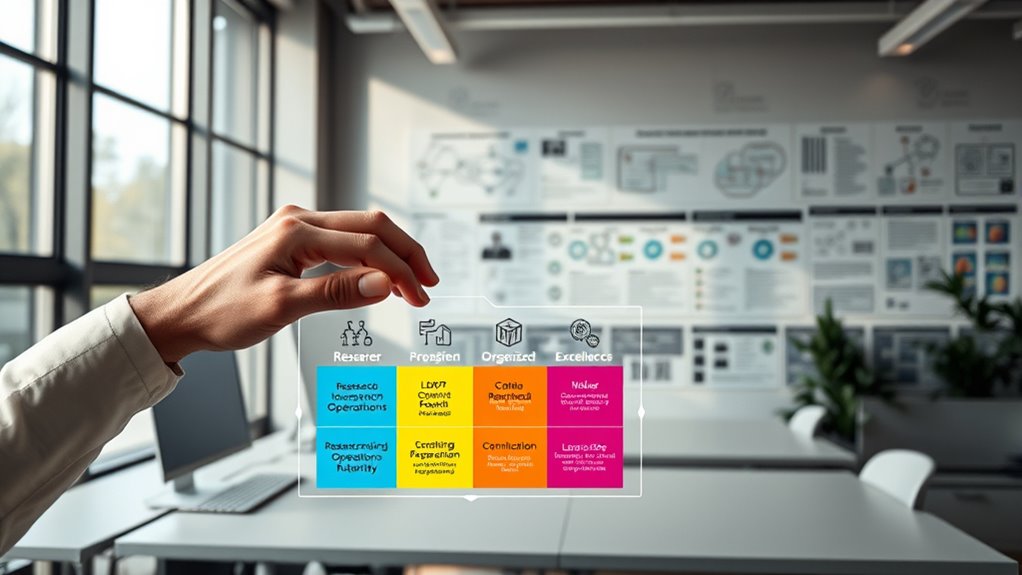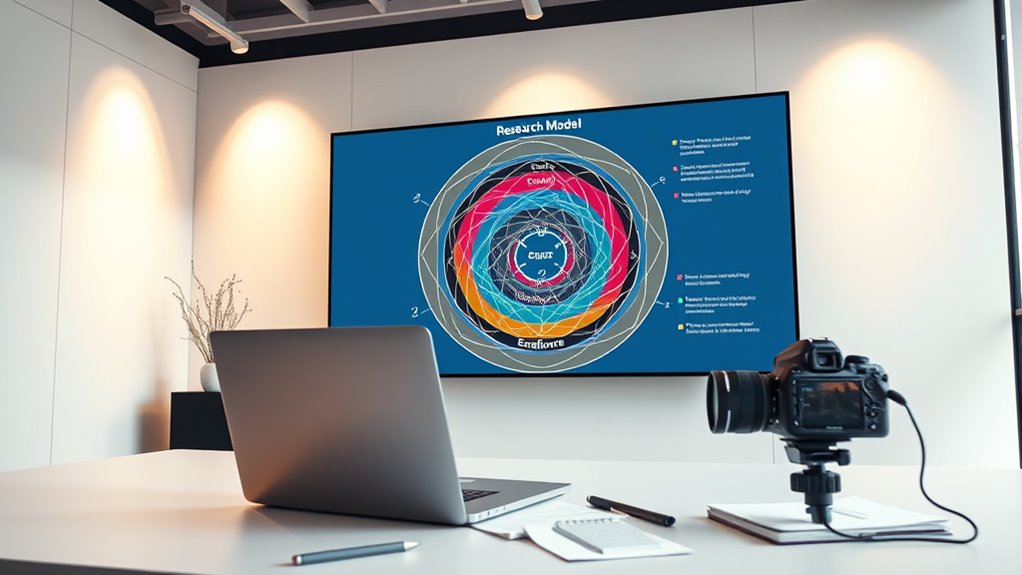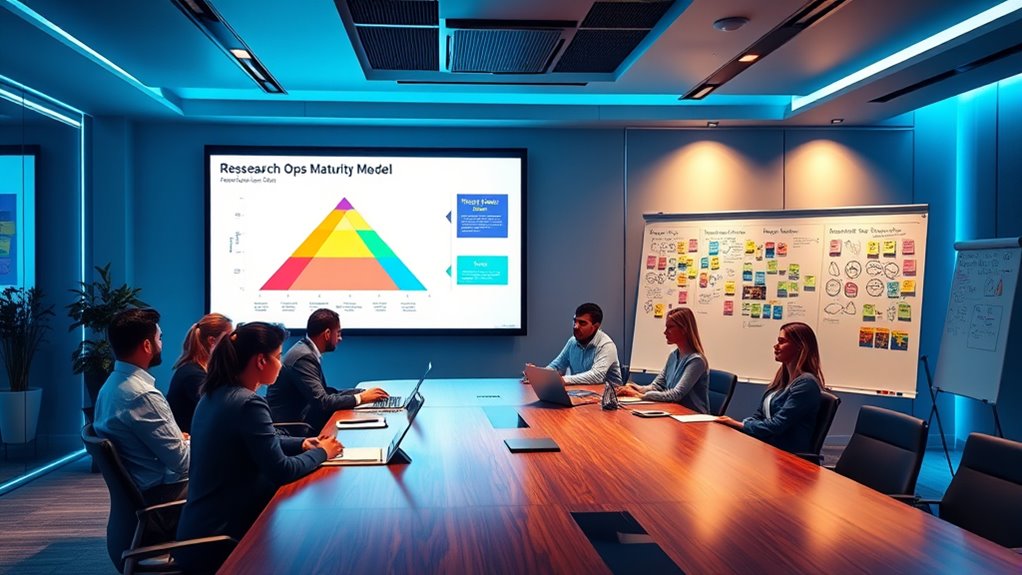To move from research chaos to a center of excellence, first recognize signs like burnout, misaligned stakeholders, and project delays. Next, assess your current maturity level and establish standardized processes for documentation, workflows, and ethical practices. Implement user-friendly tools, foster collaboration, and create a knowledge-sharing culture. Regularly measure impact and adapt strategies. Continuing this path leads to a sustainable, high-performing research operation—exploring these steps further can help you transform your research environment effectively.
Key Takeaways
- Assess current research operations to identify chaos signs like misalignment, delays, and burnout, then develop targeted strategies.
- Establish standardized processes, documentation, and protocols to create transparency, consistency, and a solid operational foundation.
- Implement integrated tools and foster knowledge sharing to improve efficiency, collaboration, and continuous learning.
- Build a Center of Excellence by setting standards, engaging stakeholders, and promoting a culture of best practices and ongoing improvement.
- Embed the CoE into organizational culture, ensuring long-term sustainability through continuous adaptation, leadership support, and a focus on researcher well-being.
Recognizing the Signs of Research Operations Chaos

When research operations become disorganized, signs quickly emerge that indicate chaos is taking hold. You might notice research burnout among your team, with fatigue and frustration spreading rapidly. Stakeholder misalignment also becomes evident, as teams struggle to stay on the same page or meet expectations. Projects may face delays, and communication breakdowns become frequent. You might find requests overlapping or conflicting, causing confusion and duplicated effort. These issues often stem from a lack of clear processes or ownership, leading to missed deadlines and lowered morale. A lack of project management capabilities can exacerbate these problems, making it even harder to regain control. Recognizing these early warning signs helps you understand that your research operations are veering off course. Addressing these symptoms promptly can prevent further chaos and set the stage for implementing a structured, mature research operations framework.
Assessing Your Current Maturity Level

To understand where you stand, start by identifying key maturity level indicators within your research operations. Next, evaluate your current processes honestly to spot strengths and areas needing improvement. This assessment sets the foundation for targeted growth and effective strategy development. Incorporating investment diversification strategies, such as adding precious metals like gold, can further enhance your research portfolio’s resilience.
Maturity Level Indicators
Evaluating your current research operations maturity begins with identifying key indicators that reflect your team’s capabilities and processes. One essential indicator is stakeholder engagement; assess how effectively your team collaborates with stakeholders, incorporates feedback, and maintains transparency. Strong engagement signals a more mature level. Resource allocation is another critical marker—examine whether resources are efficiently distributed, prioritized, and aligned with strategic goals. Mature teams optimize resource use, reducing waste and increasing impact. Additionally, look at your documentation practices, automation levels, and consistency in workflows. These indicators reveal your team’s operational stability and readiness to evolve. Recognizing team dynamics and how they influence collaboration is also vital for understanding your current state. By pinpointing these elements, you create a clear picture of where your research operations currently stand and what needs attention to progress toward a more advanced maturity level.
Current Process Evaluation
Evaluating your current research operations maturity requires a clear understanding of your existing processes and practices. Start by mapping out how your team manages user engagement, identifying strengths and gaps in capturing user insights effectively. Assess how well stakeholder alignment exists across teams and leadership, ensuring everyone shares a common understanding of goals and priorities. Examine your workflows, tools, and communication channels to determine their efficiency and consistency. Gather feedback from team members and stakeholders to uncover pain points and areas for improvement. This evaluation helps you identify where you stand in the maturity model, providing a solid foundation to develop targeted strategies. Understanding your current processes enables you to make informed decisions that align with your desired future state. Additionally, considering the Gold IRA investments can promote diversification and stability in your research portfolio, especially during fluctuating market conditions.
Building Foundations for Standardized Processes

To build a strong foundation, you need to establish clear protocols that everyone can follow consistently. Developing standardized documentation guarantees your team stays aligned and maintains quality across projects. These steps set the stage for more efficient, scalable research operations. Incorporating effective tools like Pimple Patches can further support targeted treatment and consistency in your processes.
Establish Clear Protocols
Establishing clear protocols is essential for building a solid foundation that supports standardized research processes. You need well-defined procedures for managing User Experience research, ensuring consistency across projects. These protocols help your team understand how to plan, execute, and analyze studies efficiently. Equally important are Ethical Considerations; protocols must prioritize participant safety, privacy, and informed consent. By clearly outlining these standards, you minimize risks and uphold integrity throughout your research. Consistent procedures also streamline onboarding and collaboration, making your processes more reliable and scalable. Remember, the goal is to create transparent, repeatable steps that everyone follows, fostering trust and quality in your insights. Clear protocols serve as a backbone, guiding your team from chaos toward a more organized and ethical research environment.
Develop Consistent Documentation
Developing consistent documentation is essential for creating a reliable foundation that supports standardized research processes. Clear research documentation ensures everyone understands protocols, methodologies, and findings consistently across teams. By establishing consistency standards, you minimize confusion and reduce errors, making your research more reproducible and trustworthy. Well-organized documentation also facilitates onboarding new team members and streamlines knowledge sharing. To develop effective documentation, define templates, naming conventions, and version control practices. Regularly review and update your research documentation to maintain accuracy and relevance. This disciplined approach helps embed best practices into your research operations, transforming chaos into clarity. Incorporating structured documentation practices helps ensure your research remains accessible and maintainable over time. Ultimately, consistent documentation empowers your team to execute processes efficiently, ensuring your research efforts align with organizational standards and long-term goals.
Implementing Effective Tools and Technologies

Choosing the right tools and technologies is essential for enhancing research operations, as they directly impact efficiency and collaboration. Focus on seamless tool integration to guarantee all systems work harmoniously, reducing manual work and data silos. Select platforms that align with your team’s workflows and research needs. Once chosen, prioritize user training to maximize adoption and effective use. Providing clear guidance helps team members understand features and best practices, minimizing resistance and errors. Regularly evaluate your tools to identify gaps or redundancies, and stay updated on new solutions that can improve your processes. Additionally, understanding legal and procedural requirements, such as Louisiana alimony laws, can help inform research strategies and compliance considerations. By carefully implementing the right technologies and supporting your team through training, you create a solid foundation for more organized, streamlined research operations.
Fostering Collaboration and Knowledge Sharing

Effective research operations rely not only on the right tools but also on how well your team collaborates and shares knowledge. Facilitating cross-team communication is essential to break down silos and promote alignment. Encourage regular interactions through meetings, shared channels, and collaborative platforms. Building strong knowledge repositories ensures information is accessible, organized, and up-to-date, allowing team members to find insights quickly. Foster a culture where sharing learnings and best practices is valued. When everyone contributes to and consults shared resources, it enhances efficiency and reduces redundancy. Clear communication channels and well-maintained repositories create an environment where knowledge flows seamlessly, empowering your team to work cohesively and innovate effectively.
Measuring Impact and Continuous Improvement

How do you know your research efforts are making an impact? By tracking both quantitative metrics and qualitative feedback. Quantitative metrics, like survey response rates, task completion times, and usability scores, provide measurable insights into your work’s effectiveness. Meanwhile, qualitative feedback from stakeholders offers context, highlighting how research influences decision-making and team confidence. Regularly reviewing these data points helps you identify trends and areas for improvement. Continuous improvement depends on your willingness to adapt based on these insights, refining your methods and focus. By combining hard data with honest feedback, you create an all-encompassing picture of your research’s value. Incorporating diverse content types from various sources ensures a comprehensive understanding of your impact. This approach ensures your efforts evolve, stay aligned with organizational goals, and ultimately drive meaningful progress.
Achieving and Sustaining Center of Excellence

What does it take to establish and maintain a Center of Excellence (CoE) that truly elevates your research practice? First, focus on delivering exceptional user experience by streamlining processes and fostering collaboration. Consistently engaging stakeholders ensures their needs and insights shape the CoE’s direction, keeping it relevant and impactful. To sustain the CoE, establish clear standards, share best practices, and promote a culture of continuous learning. Regularly measure performance and adapt strategies based on feedback. Leadership commitment is vital; it champions the vision and resources needed to keep the CoE vibrant. Additionally, incorporating essential oils for ongoing well-being can support a healthy, focused environment that nurtures innovation. Ultimately, a successful CoE becomes an integral part of your organization’s DNA, continuously improving and aligning research efforts with business goals. This ongoing commitment guarantees the CoE remains a true center of excellence.
Frequently Asked Questions
How Long Does It Typically Take to Progress Through the Maturity Levels?
You’re likely wondering about the research timeline to reach maturity benchmarks. It varies based on your team’s resources, goals, and current processes. Typically, progressing through levels takes from several months to a few years, depending on how quickly you implement best practices and optimize workflows. Staying consistent and focused on your research ops goals helps accelerate this journey, ultimately transforming chaos into a well-oiled center of excellence.
What Are Common Pitfalls When Transitioning to a Center of Excellence?
You might feel like you’re climbing Mount Everest when shifting to a Center of Excellence. Common pitfalls include poor change management, which can cause chaos, and neglecting stakeholder engagement, leading to resistance. Ignoring these areas can derail progress, making the journey longer and more painful. To succeed, you must prioritize clear communication, foster collaboration, and actively involve stakeholders, transforming potential pitfalls into stepping stones toward your ultimate goal.
How Can Leadership Best Support Research Operations Transformation?
Leadership can best support research operations transformation by prioritizing stakeholder engagement and effective change facilitation. You should actively involve key stakeholders early, listen to their concerns, and communicate the vision clearly. By championing the change and providing resources, you help teams adapt smoothly. Your leadership in fostering collaboration and demonstrating commitment encourages buy-in, making the transition smoother and more sustainable.
What Metrics Are Most Effective for Tracking Research Maturity?
You should focus on metrics that gauge your research maturity effectively. Qualitative benchmarks help you understand team collaboration and process improvements, while technology integration metrics reveal how well tools support your workflows. By tracking these, you get a clear picture of progress. Regularly assess how your team adopts new tools and methodologies, and use insights to refine processes, ensuring your research operations evolve smoothly toward excellence.
How Do You Tailor the Model for Different Organizational Sizes?
Think of your organization as a ship steering through different waters. To tailor the research scale and organizational flexibility, you adjust your sails based on size. Smaller teams need agility, so focus on quick wins and simple processes. Larger organizations require structured frameworks that scale. By understanding your ship’s size and flexibility, you steer your research operations smoothly from chaos toward a reliable center of excellence.
Conclusion
By transforming your research ops from chaos to a center of excellence, you’re not just optimizing processes—you’re revolutionizing your entire organization. Embrace this journey with unwavering commitment, because reaching that pinnacle isn’t just an achievement; it’s a game-changing force that will elevate your impact beyond what you ever thought possible. Stay dedicated, innovate relentlessly, and watch as your research operations become the unstoppable engine driving extraordinary success.









